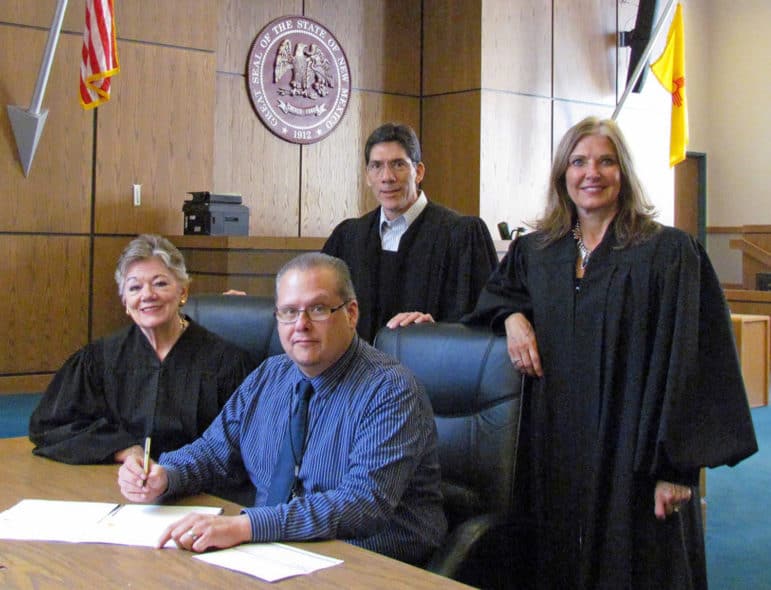
Heath Haussamen / NMPolitics.net
The Third Judicial District Courthouse in Las Cruces.
LAS CRUCES – Establishing a mental health court in Doña Ana County, officials say, would help get into treatment people who commit crimes because of underlying mental health conditions. It could also reduce recidivism and cut incarceration costs.
So-called mental health courts serve as jail-diversionary mechanisms and have been growing in popularity over the past 20 years. The number of such courts in the United States has grown from four in 1997 to more than 300 today, the Council of State Governments estimates.
Five mental health courts exist in New Mexico. They’re all in the northern part of the state.
“You see someone make a complete transformation, which in the end increases their quality of life but also public safety for our community,” Kelly Bradford, director of pretrial services at the 2nd Judicial District Court in Albuquerque, said of the mental health court in that district’s criminal division, which was established in 2003.
By the end of the two-year program, Bradford said, participants “move into situations where they have employment, some of them may be in school, they’re reunited with family, they’re engaging in counseling and therapy on their own, (and) they’re no longer cycling through the criminal justice system.”
If 3rd Judicial District Judge Mary Rosner has her way, a mental health court will be established in Doña Ana County by 2021. With the help of a $2.8 million grant, a pilot project focusing on assisted outpatient treatment is already underway and could transition into a mental health court.
“To say that we don’t have a need for a mental health court in the southern part of the state is ridiculous — of course we do,” said Rosner, who handles civil cases involving the mentally ill. She aims to create such a court with joint funding from the state, Doña Ana County and the city of Las Cruces.
According to the Urban Institute, mental health courts rely on partnerships involving treatment and social services providers, and offer problem-solving solutions for mentally ill offenders.
They are similar to drug courts and other diversionary programs, and seek to rehabilitate people through individualized treatment plans rather than incarceration when the underlying causes of crimes are mental illnesses.
Doña Ana County District Attorney Mark D’Antonio describes such diversionary programs as the “future of prosecution.”
“It separates the people who we feel can be rehabilitated or have committed crimes because of disability or drug dependence from the guys who are just criminals,” he said, “while lowering recidivism.”
The data
There is limited research on the effectiveness of mental health courts, according to the Urban Institute, but an analysis suggests such programs have moderately reduced recidivism.
The analysis, published in a 2011 edition of the Journal of Criminal Justice, reviewed 18 studies using meta-analytic techniques to assess the effectiveness of mental health courts. The findings suggest that such courts were effective intervention and resulted in a statistically significant, though modest, decrease in recidivism.
And there’s evidence that similar court programs can help people suffering from addiction.
In Doña Ana County, officials at the 3rd Judicial District Court have seen recidivism drop among those who participate in the court’s three separate drug court programs for juveniles, adults and families. Collectively, the programs have had an average recidivism rate of 13.5 percent over the past three to four years — significantly lower than the state prison recidivism rate of 53 percent, according to court officials and a 2012 legislative report.
Such programs also cost less than incarceration. In New Mexico, the average cost to a house a prisoner at a state-operated or private prison is about $93 per day. The cost to house an inmate at the Doña Ana County Detention Center is about $100 per day.
By comparison, each participant in the Adult Drug Court costs between $25 and $34 per day, while each client in the Family Reunification Court costs between $15 and $22 per day. Each participant in the Juvenile Drug Court costs between $50 and $80 per day.
“Our drug court costs, on average, are about $23 a day — so just do the math,” David Borunda, the court executive officer for the 3rd Judicial District Court, told the Sun-News in September.
He said about 90 percent of the drug court participants have a “co-occurring disorder” such as severe depression and anxiety, post-traumatic stress disorder and other mental conditions.
Some participants have even been discharged from the drug courts “because their mental health needs are greater than what our program(s) can provide,” Borunda said. “That’s where a separate mental health problem-solving court would be perfect.”

Courtesy photo
Adult Drug Court Program Manager David Borunda (center, front) and Drug Court Judges Mary W. Rosner (left), Manuel I. Arrieta (center) and Marcy E. Beyer (right). If Rosner has her way, a mental health court will be established in Doña Ana County by 2021.
Pilot project underway
Judge Rosner said the court is heading in that direction. A structure for a mental health court is currently in the “incubator” phase, she said.
Through a $2.8 million federal grant awarded to Doña Ana County, the court, under Rosner’s leadership, rolled out the assisted outpatient treatment (AOT) program this year. The program involves only people in civil cases, not those charged in criminal cases.
The county will receive $700,000 per year for the next four years, beginning in 2017, to aid people with mental illness, providing them a court-structured treatment plan. The county is one of 17 nationwide to get such a grant from Substance Abuse Mental Health Services Administration, Rosner said.
Jamie Michael, the head of the county’s Health and Human Services Department, secured the grant, outbidding Bernalillo County, according to Rosner.
There are currently 19 participants in the AOT program, but the funding allows for 30 participants in the first year and 40 in each of the next three years. Participants must have been diagnosed with an Axis-1 disorder such as schizophrenia, severe depression, post-traumatic stress disorder or bipolar disorder.
Michael said the goals of the AOT program include reducing in-patient hospitalization, incarceration and civil in-patient commitments.
“There are indicators that we look at to help measure if participants will be healthy members of the community with improved quality of life,” she said.
The SAMHSA funds cover a psychiatrist, therapists and counselors for individual and group sessions and a case manager, all of whom are contracted through the local behavioral health provider La Clinicia de Familia, Rosner said. The case manager is responsible for ensuring the participants have their medical needs met. The funds also cover psychotropic medication, she said.
The program is designed to treat an individual for at least 12 months, according to 3rd Judicial District Court Chief Judge Jim Martin. Status hearings before Rosner are held about every three months.
But the funds do not cover other items that would complete Rosner’s vision for a full-fledged mental health court, including stable sources of food, clothing, shelter, transportation and communication.
“One of the things that we absolutely must have if we’re serious about dealing with the mental health community is we need to have some sort of stability,” she said.
The program also does not yet address mentally ill individuals charged with crimes. The court identified 122 criminal cases out of 1,417 in the period between July 1, 2016, and June 30, 2017, where mental health was at issue.
How will it be funded?
Martin said he supports establishing a mental health court in the 3rd Judicial District. “But it’s expensive,” he said. “The programs around the other parts of the state — they’re budgeting upwards of $400,000 per year to run a mental health court.” The court recently estimated that it would cost $7,800 to $ 8,500 per client each year to run a mental health court in Doña Ana County.
Rosner sees the pilot program as an opportunity to demonstrate to the Legislature that a mental health court can work in Doña Ana County. “We can take it patient by patient, we can look at per quarter, we can look at by year and we see the impact on the entire society,” she said. “The police department, the sheriff’s department, our emergency room facilities, we can show real improvement in cost savings for the county – but most importantly a method or procedure or some type of structure for dealing with people with serious mental illness.”
State Rep. Bill McCamley, D-Las Cruces, also said Doña Ana County needs a mental health court, but called for existing resources, like the county’s stalled crisis triage center, to be fully utilized.
“Right now, the only place for many to get to mental health treatment is in the jail,” he said. “We don’t live in era where people have to wear straitjackets anymore … (and we) have to figure out a way to establish a mental health court here and open the crisis triage center.”
McCamley said that would require “resources to be reallocated (at the state and county levels).”
Las Cruces Mayor Ken Miyagishima said he would like the city to study and explore the logistics of helping to establish a mental health court. He also wants city officials to be involved in any discussions with Rosner and the county about funding a program.
Michael said after the four-year pilot period, the cost of the AOT program would likely be less because the county would have saved money in other areas.
“If our program is as successful as other programs around the country, then we will see some savings as a community in costs to incarcerate people,” Michael said. “We will see savings in the cost of in-patient care because people are healthier and safer in the community, because they’re engaged in their out-patient treatment.”
In addition, Michael said, the systems and people will already be in place to operate the program at that point, “so it will cost less to operate.”
Carlos Andres López can be reached 575-541-5453, carlopez@lcsun-news.com or @carlopez_los on Twitter.